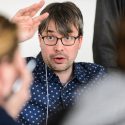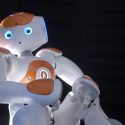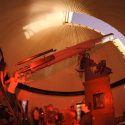Science Expeditions puts UW–Madison research on display April 1-3

Children look into microscopes and learn about stem-cell research at a hands-on exploration station during Science Expeditions in 2011. Photo: Jeff Miller
Science Expeditions, the University of Wisconsin–Madison’s 14th annual science open house, starts Friday with 8 tons of mastodon and a window out into the cosmos — and then gets really big.
This weekend, UW–Madison laboratories, museums, greenhouses and medical and animal research centers will be open to thousands of visitors, offering the public the opportunity to mix with the university’s scientists and students and learn about their work.
“Almost everyone in Wisconsin has a role in supporting the research at UW–Madison whether they have ever set foot in a building here or not,” says Tom Zinnen, outreach specialist at UW–Madison’s Biotechnology Center and UW–Extension, and a Science Expeditions organizer. “That’s why hundreds of volunteers are so willing to see the public share in the discoveries at their land-grant research university during Science Expeditions, and to connect visitors to UW–Madison’s science places and programs all year ’round.”
Science Expeditions kicks off Friday at the Genetics-Biotechnology Center Building, 425 Henry Mall, with a step back in Wisconsin history. At 7 p.m., Carrie Eaton, curator of collections at the UW–Madison Geology Museum, will talk about the mastodons that roamed North America for millions of years, and how the fossilized bones of two of the behemoths found near Madison in the 1890s became one iconic specimen in the museum’s collection.
An hour later and just a block or two north on campus, Washburn Observatory, 1401 Observatory Dr., will open for public viewing of the spring sky. An important research facility for more than five decades after it opened in 1881, Washburn and its 15.6-inch refracting telescope still offer (weather permitting) spectacular views of the stars guided by Jim Lattis, director of UW Space Place.
Saturday’s constellation of science is centered on the Discovery Building, 330 N. Orchard St., where, from 10 a.m. to 2 p.m., kids and curious adults can get hands-on with the help of volunteer UW–Madison educators and researchers at scores of Exploration Stations.
A pair of live shows on Saturday — the Wonders of Physics, at 10 a.m., noon and 2 p.m. in Chamberlin Hall, 1150 University Ave.; and SPICE (Students Participating In Chemical Education) Chemistry Demonstration Show at 11 a.m. and 2 p.m. in Room 1351 of the Chemistry Building, 1101 University Ave. — mix showmanship and spectacle with science.
The Ingersoll Physics Museum in Chamberlin Hall and Geology Museum in Weeks Hall, 1215 W. Dayton St., will be open for visitors until 4 p.m., and researchers are inviting the public in for special tours of working facilities such as the biomechanics and epidemiology labs — where engineers and biologists use virtual reality and high-tech scanners to study the complicated coordinated movement of the human body and physical activity’s important connection to health — in the Natatorium, 2000 Observatory Dr., from 10 a.m. to 2 p.m. on Saturday.
The free Science Expeditions Trolley will carry visitors and UW–Madison Campus and Visitor Relations tour guides among the event’s venues and campus parking lots on Saturday, circulating every 15 minutes from 9:30 a.m. to 4:30 p.m.
On Sunday, Science Expeditions shifts to the Health Sciences Learning Center, 750 Highland Ave., and the neighboring School of Nursing’s Signe Skott Cooper Hall, 701 Highland Ave., from 10 a.m. to 2 p.m. for more Exploration Stations and tours of UW Health’s Clinical Simulation Program and the School of Nursing’s Center for Technology-Enhanced Nursing. The centers include simulated hospital and clinic environments where students work with humanlike, interactive manikins to build their clinical skills.
Madison entertainer Truly Remarkable Loon juggles giant beanbag chairs, spins plates and tosses scary things during a special performance at Signe Skott Cooper Hall at 2 p.m. — following a juggling workshop in the hall’s lobby from noon to 1:30.
For a full look at the packed schedule for Science Expeditions, with parking and maps of campus locations, visit the event’s website.
Other highlights include:
- A break from the still-chilly spring with Saturday tours of the warm and humid air and leafy green confines of the Botany Greenhouses on the south side of Birge Hall, 430 Lincoln Dr., and D.C. Smith Greenhouse, 465 Babcock Dr., and the greenhouse atop Leopold Residence Hall, 1635 Kronshage Dr., where student residents grow some of their own food.
- Glassblowing demonstrations and tours of the Glass Shop, where specialized scientific instruments are conceived and hand-crafted, Saturday from 10 a.m. to 2 p.m. in the Chemistry Building, 1101 University Ave.
- The endless march of leaf-cutter ants, which do their own version of farming in a display colony in the Microbial Sciences Building, 1550 Linden Dr.
- Outdoor events, like a 2 p.m. Sunday walk and outdoor Exploration Stations at Picnic Point guided by Friends of the Lakeshore Nature Preserve that begin near Parking Lot 129, 2004 University Bay Dr.; and UW–Madison Arboretum activities and a walk with naturalists describing the spring awakening starting at 1 p.m. Sunday at the Arboretum Visitor Center, 1207 Seminole Highway.



